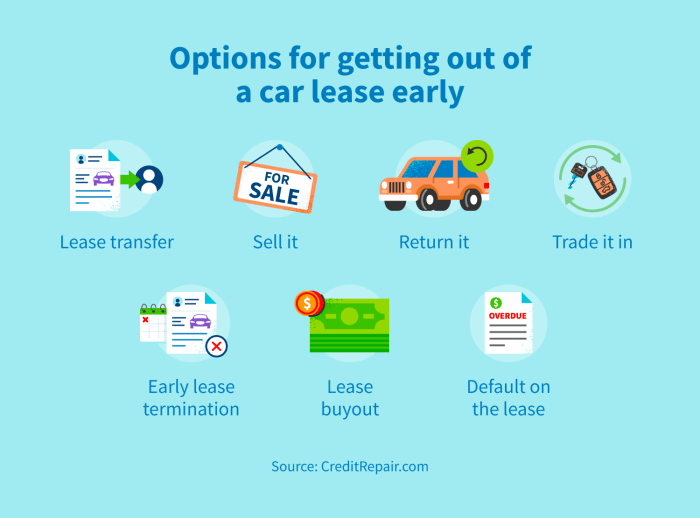How to get out of a car lease early? It’s a question a lot of college students (and, let’s be honest, everyone else) finds themselves asking at some point. Maybe life threw you a curveball, your financial situation shifted, or you just plain found a better deal. Whatever the reason, breaking a car lease isn’t always a walk in the park.
This guide breaks down the process, exploring your options from negotiating with the leasing company to understanding the potential financial hit—so you can make the smartest move for your wallet.
We’ll walk you through everything from deciphering the fine print of your lease agreement to exploring less painful alternatives like lease transfers or refinancing. We’ll even give you some sample scripts and letters to help you navigate those awkward conversations with your leasing company. Get ready to ditch that lease—smartly.
Understanding Your Lease Agreement
Getting out of a car lease early isn’t always a walk in the park. Before you even think about contacting the dealership, you absolutelyneed* to understand the fine print of your lease agreement. This document is your bible for early termination, outlining the rules and potential financial consequences.Understanding the terms and conditions related to early lease termination is crucial.
This section details what you’ll find in your contract and how it impacts your ability to break the lease early. Failure to understand these terms can lead to unexpected and potentially significant financial burdens.
Early Termination Penalties and Fees
Lease agreements typically include clauses specifying penalties for early termination. These penalties can vary widely depending on the leasing company, the length of the lease remaining, and the vehicle’s market value. Common penalties include early termination fees (a flat fee), excess wear and tear charges (based on the condition of the vehicle), and potentially a disposition fee (covering the cost of selling the vehicle).
For example, one leasing company might charge a $500 early termination fee plus the difference between the vehicle’s residual value (the value at the end of the lease term as specified in the contract) and its current market value. Another might charge a percentage of the remaining lease payments. It’s vital to carefully review your specific agreement to understand the exact calculation method used.
Locating the Early Termination Clause
Finding the relevant clause in your lease agreement might seem daunting, but it’s a straightforward process. First, skim the table of contents or index (most agreements have these) to find sections dealing with “early termination,” “lease default,” or “breach of contract.” These sections typically Artikel the process for ending the lease prematurely and the associated financial repercussions. If you can’t locate it through the index, read the entire agreement thoroughly.
Pay close attention to sections on payment terms, lease duration, and any clauses detailing responsibilities should the lease end before its scheduled completion date. The specific wording might vary, but the core information – the penalties and procedures – should be clearly stated. If you are still struggling to locate the information, consider contacting the leasing company directly for clarification.
They are legally obligated to provide you with this information.
Exploring Options for Early Lease Termination

Getting out of a car lease early isn’t ideal, but sometimes life throws curveballs. Fortunately, you have a few options, though none are guaranteed to be painless. Understanding your choices and approaching them strategically can significantly impact your financial outcome. Let’s explore your possibilities.
Lease Transfer or Assignment
Transferring your lease to another qualified driver can be a viable way to avoid early termination fees. Essentially, you’re finding someone to take over the remaining payments and responsibilities of your lease agreement. This often requires the approval of your leasing company, who will likely verify the new lessee’s creditworthiness and driving history. The process typically involves completing an application and paying a small administrative fee.
Successfully transferring your lease is contingent on finding a suitable candidate and navigating the leasing company’s requirements. Advertising your lease on online forums or marketplaces dedicated to vehicle transfers can increase your chances of finding a suitable replacement. Be aware that you might still be held responsible for the lease if the new lessee defaults on payments.
Negotiating with the Leasing Company
Directly negotiating with your leasing company to reduce or waive early termination fees can sometimes yield positive results. Be prepared to explain your circumstances clearly and concisely. Demonstrating a history of timely payments and responsible behavior can strengthen your position. A compelling reason for needing to end the lease, such as a job relocation or unforeseen financial hardship, can also be helpful.
Don’t be afraid to propose a compromise, such as paying a reduced fee or making a lump-sum payment to cover a portion of the remaining lease obligations. Remember to document everything in writing, including any agreements reached. It’s crucial to be polite but firm in your negotiations, as this approach is more likely to yield favorable outcomes.
Purchasing the Vehicle
Buying out the lease allows you to own the vehicle outright, effectively ending the lease agreement. This typically involves paying the leasing company the remaining lease payments, plus any early termination fees and the vehicle’s residual value (the predetermined value of the car at the end of the lease term). This option can be costly, but it provides the benefit of owning the car.
Before deciding to purchase, it’s important to compare the buyout price with the current market value of the vehicle to ensure you aren’t overpaying. If the buyout price is significantly higher than the market value, exploring other options might be more financially beneficial. Carefully review the terms and conditions of your lease agreement to understand the exact buyout process and associated costs.
Financial Implications of Early Lease Termination

Getting out of a car lease early can be expensive. Before you decide to break your lease, it’s crucial to understand the potential financial hit. Several factors contribute to the overall cost, and carefully weighing these factors against your reasons for wanting out is essential. Ignoring the financial implications could lead to unexpected debt and financial strain.
The cost of early termination varies significantly depending on your lease agreement and the method you choose to exit. Lease agreements often include hefty early termination fees, and you’ll still owe payments for the remainder of the lease term. Let’s break down the financial aspects in more detail.
Early Termination Cost Comparison
The following table illustrates the financial impact of various early termination options. Remember, these are hypothetical examples, and your actual costs will depend on your specific lease agreement and the current market value of your vehicle.
| Option | Fee | Remaining Payments | Total Cost |
|---|---|---|---|
| Lease Buyout | $0 (but you pay the remaining lease value) | $5,000 (Example: 10 months left at $500/month) | $5,000 |
| Early Termination Fee (as specified in contract) | $2,500 (Example) | $5,000 (Example: 10 months left at $500/month) | $7,500 |
| Finding a Sublessee | $0 (ideally) | $0 (if sublessee takes over payments) | Variable (depending on finding a suitable sublessee and transferring the lease) |
| Vehicle Return (if allowed) | Variable (depending on vehicle condition and mileage exceeding limits) | $0 (if no further payments are required) | Variable (potentially significant excess mileage/damage fees) |
Hypothetical Scenario: Cost-Benefit Analysis
Imagine you’re 12 months into a 36-month lease with 24 months remaining. Your monthly payment is $
500. Your lease agreement states a $2,000 early termination fee. Let’s analyze three options:
- Option 1: Continue the Lease: This costs you $500/month x 24 months = $12,000.
- Option 2: Pay the Early Termination Fee: This costs you $2,000 (fee) + ($500/month x 24 months) = $14,000. This option is more expensive than continuing the lease.
- Option 3: Find a Sublessee: If you successfully find a sublessee to take over your lease, your cost could be $0 (excluding any fees associated with lease transfer). This is the most financially favorable option, but it’s also the most uncertain.
Calculating Total Early Termination Cost
The total cost of early lease termination is the sum of the early termination fee (if any) and the remaining lease payments. The formula is:
Total Cost = Early Termination Fee + (Monthly Payment x Number of Remaining Months)
For example, if your early termination fee is $1,500 and you have 18 months remaining at $400/month, your total cost would be: $1,500 + ($400 x 18) = $8,700.
Alternatives to Early Termination: How To Get Out Of A Car Lease Early

Getting out of a car lease early can be costly, so exploring alternatives is crucial. Before you decide to break your lease, consider strategies that might alleviate financial pressure and allow you to keep your vehicle. These options can save you significant money compared to the early termination fees and potential negative impacts on your credit score.
Often, financial hardship is the primary reason for considering early lease termination. However, proactively addressing these financial challenges might eliminate the need to break your lease altogether. By exploring various solutions, you may find a path that allows you to fulfill your lease agreement without incurring substantial penalties.
Managing Monthly Payments More Effectively
Effective budget management can often alleviate the stress of high monthly lease payments. Carefully reviewing your spending habits and identifying areas for potential savings is a critical first step. This might involve reducing discretionary spending, such as eating out less frequently or canceling unnecessary subscriptions. Creating a detailed budget, tracking your expenses, and identifying areas for improvement can help you regain control of your finances.
Another strategy involves exploring additional income streams. This could involve taking on a part-time job, freelancing, or selling unused items. Even small amounts of additional income can make a significant difference in your ability to manage your lease payments. For example, if you can earn an extra $200 per month through a side hustle, this could significantly reduce the strain of your lease payments.
Refinancing the Lease to Lower Monthly Payments
Refinancing your lease is another viable option, though it’s not always feasible. This involves securing a new lease agreement with a different lender, potentially offering lower monthly payments. Several factors influence the possibility of refinancing, including your credit score, the remaining term of your lease, and the current market conditions.
For instance, if interest rates have dropped since you initially leased your vehicle, refinancing could result in lower monthly payments. However, it’s important to carefully compare the terms and conditions of the new lease agreement before proceeding. Hidden fees or less favorable terms could negate any benefits of the lower monthly payments. You might need to consult with a financial advisor or auto loan specialist to determine the feasibility and potential benefits of refinancing your lease.
Legal Considerations
Getting out of a car lease early often involves navigating a complex legal landscape. Both you, as the lessee, and the leasing company have specific rights and responsibilities Artikeld in your lease agreement and by state and federal laws. Understanding these legal aspects is crucial to protect your interests and avoid unnecessary financial burdens.Understanding Lessee and Leasing Company Rights and ResponsibilitiesLessees have the right to terminate a lease early, but usually only under specific circumstances Artikeld in the contract or by law (e.g., military deployment, job relocation to a significant distance from where the car is kept).
However, early termination typically incurs penalties. Leasing companies have the right to enforce the terms of the lease agreement, including charging early termination fees. These fees are often substantial and calculated based on the remaining lease payments, plus potential losses the company incurs from reselling the vehicle. Both parties are bound by the terms of the legally binding contract, and any disputes should be addressed according to the procedures Artikeld within the contract itself or through legal channels.
Dispute Resolution Procedures for Unreasonable Fees
If you believe the early termination fees charged are unreasonable or violate the terms of your contract, you have legal avenues to dispute them. The first step is typically to review your lease agreement carefully and compile any documentation that supports your claim. This might include evidence of misrepresentation by the leasing company, unforeseen circumstances that justify early termination (with proper supporting documentation), or proof that the fees exceed what is reasonably stipulated in the contract.
Next, you should attempt to negotiate a settlement directly with the leasing company. Many companies have internal dispute resolution processes. If negotiation fails, you may need to consider mediation or arbitration, which can be less expensive and time-consuming than litigation. As a last resort, you can file a lawsuit in small claims court or seek legal representation to pursue your claim in a higher court.
The specific procedures will vary depending on your state’s laws and the specifics of your case. For example, some states have laws limiting the amount of early termination fees a leasing company can charge.
Resources for Legal Advice
Seeking legal counsel is advisable if you’re facing difficulties with early lease termination. Several resources can provide assistance:Legal Aid Societies: These organizations offer free or low-cost legal services to individuals who meet specific income requirements. They can provide advice and potentially represent you in legal proceedings.Consumer Protection Agencies: State and federal consumer protection agencies can investigate complaints against leasing companies and may be able to help resolve disputes.Private Attorneys: Consulting with a private attorney specializing in consumer law or contract disputes can provide personalized advice tailored to your specific situation.
Many lawyers offer initial consultations at a reduced rate or for free.Online Legal Resources: Websites and online legal databases may offer information about lease termination laws in your state and provide sample legal documents. However, it’s important to remember that this information is generally not a substitute for professional legal advice.
Communicating with the Leasing Company
Getting out of a car lease early often requires navigating the sometimes-complex world of leasing agreements and company policies. Effective communication with your leasing company is key to a smooth (or at least, less stressful) process. Whether you’re writing a letter or making a phone call, a professional and assertive approach is essential to getting your point across and potentially achieving a favorable outcome.
Remember, maintaining a respectful and professional tone throughout the communication process is vital, even if you’re frustrated. Your goal is to work collaboratively towards a solution, not to antagonize the leasing company representative. Clear, concise communication will help you achieve this goal.
Sample Letter Requesting Early Lease Termination
A well-written letter provides a documented record of your request and the details of your situation. This formal approach is beneficial for both parties. It’s also a great way to clearly lay out your case, including any mitigating circumstances.
To: [Leasing Company Name and Address]
From: [Your Name and Address]
Date: [Date]
Subject: Request for Early Termination of Lease Agreement – Account Number [Your Account Number]Dear [Leasing Company Contact Person, if known, otherwise use “Sir/Madam”],I am writing to request early termination of my lease agreement for vehicle [Vehicle Identification Number (VIN)], account number [Your Account Number]. My lease agreement began on [Lease Start Date] and is currently scheduled to end on [Lease End Date].Due to [Clearly and concisely explain your reason for early termination.
Getting out of a car lease early can be a headache, especially if you’re facing penalties. Sometimes, a driving infraction leads to needing SR-22 insurance, which can be pricey. If you’re in that boat, check out this resource for Cheap SR-22 insurance for high-risk drivers to help manage costs. Then, you can focus on figuring out the best way to break your lease without completely blowing your budget.
Be specific and provide supporting documentation if possible. Examples: unexpected job relocation, unforeseen financial hardship, vehicle mechanical issues].I understand there may be financial penalties associated with early termination, and I am prepared to discuss these fees. I would appreciate it if you would Artikel the specific costs involved and explore any potential options for minimizing these charges.I look forward to your prompt response and the opportunity to discuss this matter further.
You can reach me at [Your Phone Number] or [Your Email Address].Sincerely,
[Your Signature]
[Your Typed Name]
Sample Phone Conversation Script
A phone call can be a quicker way to get information and potentially negotiate. However, it’s important to be prepared and have all necessary information readily available. This includes your lease agreement details, the reason for early termination, and any supporting documentation.
So, you’re trying to ditch that car lease early? It’s a pain, but sometimes life throws curveballs. One thing to consider is your insurance – if you’re suddenly looking for a new ride, you might need a new policy, especially if your driving record isn’t perfect. Check out this list of Best high-risk auto insurance companies 2025 to find a good fit.
Getting out of your lease might mean a higher insurance premium initially, so plan accordingly.
You: “Hello, my name is [Your Name], and my account number is [Your Account Number]. I’m calling to discuss early termination of my lease agreement.” Representative: “[Representative’s response]” You: “I understand there may be fees associated with early termination. I’m calling to understand what those fees would be and explore any possible options for reducing them. My reason for early termination is [briefly explain your reason].” Representative: “[Representative’s response]” You: “Thank you for explaining the options.
I’d like to [State your desired next step: e.g., ‘review the buyout options in writing,’ ‘discuss this further with a supervisor,’ ‘consider the early termination fee’ etc.].” Representative: “[Representative’s response]” You: “Thank you for your time and assistance. I will [State your next step: e.g., ‘await the written buyout offer,’ ‘call back tomorrow,’ etc.].”
Professional and Assertive Communication Strategies
Professionalism and assertiveness are not mutually exclusive. Assertiveness involves clearly stating your needs and desires while respecting the other person’s perspective. Professionalism maintains a courteous and respectful tone throughout the interaction.
Examples include using “I” statements to express your needs (“I need to terminate my lease early due to…”), actively listening to the representative’s responses, and remaining calm and respectful even if the conversation becomes challenging. Avoid accusatory language or raising your voice. Documenting all communication (phone calls, emails, letters) is crucial for your records.
Illustrative Examples
Let’s look at some real-world scenarios to illustrate how getting out of a car lease early might play out. These examples highlight different approaches and their potential outcomes, emphasizing the importance of understanding your lease agreement and exploring all available options.Lease transfers, negotiations, and buyouts each present unique pathways, with varying levels of success depending on individual circumstances and the leasing company’s policies.
Remember, thorough research and proactive communication are key to navigating this process effectively.
Lease Transfer: A Viable Option
Imagine Sarah, a recent graduate, leased a car for three years but landed a job requiring a cross-country move. She found her current vehicle unsuitable for her new location and lifestyle. A lease transfer became a viable option. Through online marketplaces specifically designed for lease transfers, she found someone willing to take over her lease. The process involved completing a transfer application with her leasing company, providing the new lessee’s information and credit check.
Sarah had to pay a small transfer fee, but this was significantly less than the early termination penalty. Challenges included finding a suitable candidate with good credit and meeting the leasing company’s approval criteria. The process took several weeks, requiring consistent communication with both the prospective lessee and the leasing company. In the end, however, it proved to be a more cost-effective solution compared to other options.
Successful Negotiation with the Leasing Company, How to get out of a car lease early
John leased a luxury SUV but experienced unexpected financial hardship due to a job loss. Facing an early termination fee of several thousand dollars, he contacted his leasing company to explain his situation. He presented documentation supporting his claim of financial difficulty, including his termination letter and unemployment benefits paperwork. Through persistent and polite negotiation, he successfully convinced the leasing company to reduce his early termination fee by approximately 40%.
The negotiation involved several phone calls and email exchanges, requiring him to be assertive yet understanding. The leasing company ultimately agreed to a compromise, recognizing the extenuating circumstances. This outcome underscores the importance of clearly and respectfully explaining your situation, and providing compelling evidence to support your request.
Vehicle Buyout: The Most Cost-Effective Solution
Maria leased a compact car for two years, but after eighteen months, she discovered she needed a larger vehicle to accommodate her growing family. She explored her options and found that buying out her lease was actually the most financially sound choice. After calculating the remaining lease payments and the vehicle’s current market value, she determined that purchasing the vehicle outright, even with a slightly inflated buyout price, was cheaper than paying the early termination fee and then leasing a new car.
This scenario highlights the importance of carefully comparing all available options, including the potential cost of early termination versus the cost of purchasing the vehicle. She secured financing with a favorable interest rate, ensuring the overall cost remained manageable.
End of Discussion
So, escaping that car lease early isn’t impossible, but it does require some strategic planning and a willingness to do your homework. Remember, understanding your lease agreement is key. Weigh the costs and benefits of each option—lease transfer, negotiation, buyout, or even exploring alternatives like refinancing. Don’t be afraid to reach out to the leasing company and communicate your situation clearly and professionally.
With a little savvy and some careful planning, you can get out of that lease and move on to greener pastures (or, you know, a better car).









